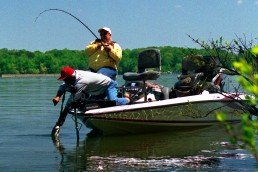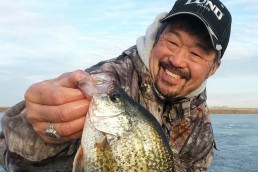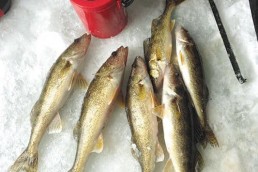Sometimes it’s Good to Jig and Sometimes it Isn’t
SHARE THIS POST
Mike’s float began to slowly sink in the ice hole as he reached for his ice rod. Fernando quickly bent over, reaching for his own ice rod.
“I got a strike, too,” he said.
Both Mike and Fernando set the hook and their light ice rods were bent and tips were bouncing as their fish raced off. Looking down to see my float disappearing into the ice hole, I reached for my ice rod to set the hook. I could feel something on the other end, but it felt different than a fish racing off. Then I noticed every time Mike pulled up on his rod I could feel it on my line. I told Mike I thought I was snagged on his line.
Then Fernando said he thought he was snagged too. Mike pulled up on his line and both Fernando’s and my line felt it. It looked like Mike’s fish probably tangled all three lines together. That sometimes happens. Fernando and I flipped open the bails on our spinning reels and Mike reeled his line in.
“I think I still have a fish on,” Mike said, as he brought his line in.
A moment later, a silver fish flashed in the ice hole and Mike flipped a keeper-sauger onto the floor of the ice house. It didn’t surprise me to see the fish with all three lines wrapped around it, but what did surprise me was it had two hooks in its mouth.
It took a couple of minutes to sort out whose line was whose, but after we untangled the lines we discovered the fish had both Mike’s and Fernando’s hooks in it. It must have been one hungry fish to hit two baits at the same time. It was one of the oddest things I have seen while ice fishing, making for another memorable Lake of the Woods fishing experience.
There were four of us ice fishing at Lake of the Woods. My son-in-law Damien Aguilar and his father Fernando, and Mike Hallas all from Minnesota’s Twin Cities, along with myself were fishing in late February out of Arnesen’s Rocky Point Resort near Roosevelt, Minn.
It was a mild winter day with gray skies and a stiff wind as we left the resort in one of their bombardiers on the way to our ice house. (Bombardiers are vans on tracks, which can take up to a dozen at a time across the ice to their ice houses.)
We can fish two lines in Minnesota, so we each set out one rod with a hook and a minnow under a slip bobber and the other rod with an ice jig. In the first couple of hours, we got a number of strikes on slip bobber rods, but nothing on the jig. It didn’t take a rocket scientist to figure this out. The jigs weren’t working, so we pulled in our jig lines, replacing them with hooks and minnows under slip bobbers. Shortly after that we noticed we started to get a lot more action. Damien caught the big fish of the day—a 17-inch sauger. As the day went on, we caught over 25 fish, keeping five saugers and one big perch for our fish fry on our last evening.
Are you enjoying this post?
You can be among the first to get the latest info on where to go, what to use and how to use it!
We were fishing within 2 inches of the bottom. Any time we fished any higher we just didn’t get any strikes. It was late in the season, so perhaps the fish were reacting to the season-long effect of too much fishing pressure or perhaps it was the weather. There was talk of storms on the way too. For whatever reason the fish just weren’t active, so the more subtle approach with minnows under floats worked far better than jigging.
The next day was colder, with snow covering the car as we prepared to head from our cabin to the resort. It didn’t look like anything would have changed overnight so we started fishing both ice rods with slip bobbers and minnows. We started getting strikes shortly after we set up. We were getting a lot of 11- to 12-inch saugers, which we threw back before finally Fernando caught a 14-inch sauger. We were looking for enough fish to add to the fish we caught the day before for our fish fry. By the end of the day we caught another 12 fish, keeping seven saugers and another big perch.
I enjoy fishing with ice jigs, but I have noticed fish need to be aggressive for jigs to be effective. For the last couple of years when our group makes our end-of-February ice fishing trip to Lake of the Woods, ice jigs have not worked for us.
As I look back on the last couple of years the weather has been unstable. Two years ago, we drove to Lake of the Woods in a blizzard. Inconsistent and stormy weather affects fish below the ice the same way it affects warm-water fishing.
We normally visit Lake of the Woods in the end of the February. And although the ice fishing season on Lake of the Woods extends all the way into April, as long as the ice remains safe, by the end of February Lake of the Woods—a premier walleye lake—has undergone a considerable amount of fishing pressure.
I think the combination of a long winter’s fishing pressure and fluctuating weather conditions can cause fish to be less than aggressive. Therefore, a more subtle approach is needed to be successful during these conditions. A plain hook with a minnow under a slip bobber is ideal.
Sometimes it is good to jig and sometimes it’s not.
The other key to being successful is keeping the bait close to the bottom. Walleyes and their cousins, saugers and yellow perch, are bottom-feeding fish. In late season with unsteady weather I believe these fish hug closer to the bottom. We kept our baits within 2 inches of the bottom and caught fish all day long.
On our last night after the fish were cleaned and we returned to our cabin, the fillets were rolled in breading and dropped into melted Crisco. Potatoes and onions were frying in another pan; vinegar coleslaw was placed on the table. The smell of fish frying filled the cabin as a cold wind blew around the corners outside. It was another successful fishing trip to Lake of the Woods.
MWO
SHARE THIS POST
Did you enjoy this post?
You can be among the first to get the latest info on where to go, what to use and how to use it!
Mike Yurk
Mike Yurk grew up in Oshkosh, Wis., where he first started writing about the outdoors. A retired Army officer, he is now a full-time, freelance outdoor writer. He has written more than 1000 articles for outdoor publications and published 12 books on outdoor sports. He lives in northwestern Wisconsin where he has found some of the best bass fishing in the country.




